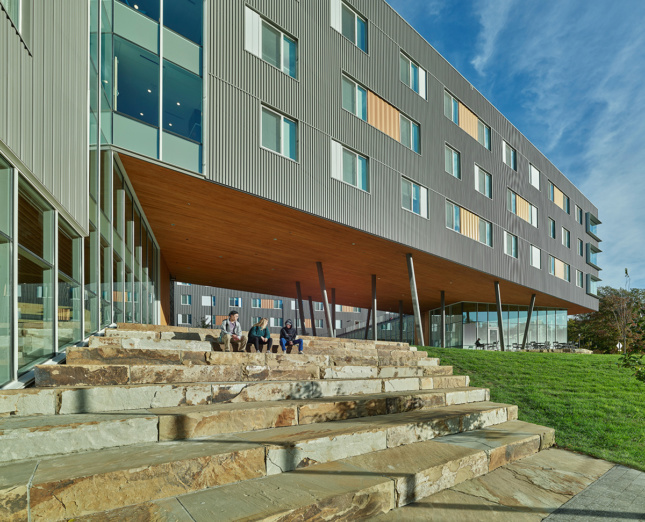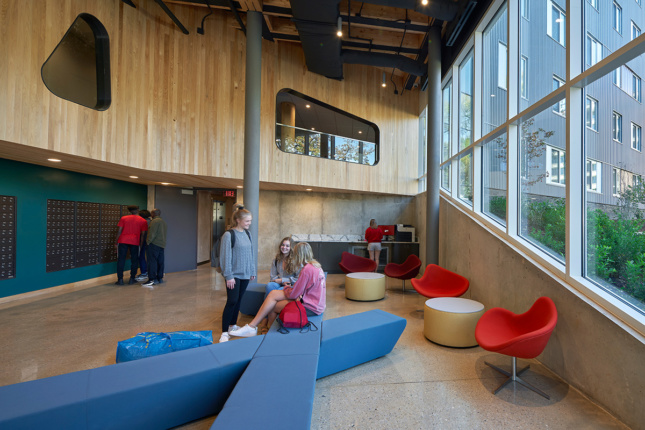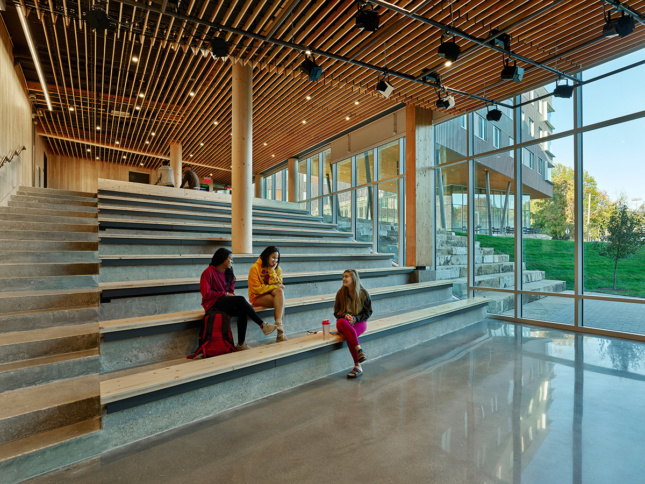America’s largest mass timber building has opened at the University of Arkansas. Spread across a series of interconnected structures, Adohi Hall is a 202,027-square-foot residential project constructed from cross-laminated timber.
Boston-based Leers Weinzapfel Associates led a national design team of heavy hitters for the $79 million project: local practice modus studio, the St. Louis-based Mackey Mitchell Architects, and Philadelphia’s OLIN helped bring the sustainable, 708-bed student complex to life. Located on a sloping, four-acre site on the Fayetteville campus’s hilly southern end, Adohi Hall features a nature-centric design with room for classrooms, a community kitchen, lounges, a rooftop terrace, and more.

Linked by a ground-level passage called the “cabin,” the large-scale, dual-volume complex snakes around the linear lot and is configured around three courtyards. As the nation’s first CLT “living learning” setting, Adohi Hall was built for undergraduates but is also targeted for architecture, design, and art students, and features ample programming to reflect that. Throughout the four-story facility, communal areas encourage collaboration while “workshops,” or maker spaces, provide students with the opportunity to rehearse or host performances, record music, or participate in other live/learn events.
The design team integrated exposed structural wood throughout the project to remind residents and visitors of the building’s groundbreaking construction. Exposed timber columns, ceilings, and trusses bring a sense of warmth to the interior spaces, while generous light also shines in through the floor-to-ceiling glass windows in the cabin area and provides views of the surrounding landscape designed by OLIN. The majority of Adohi Hall’s facade, which lightly cantilevers over the first-floor, is less obviously about wood and features zinc-toned paneling with copper and white accents.

In a statement, Andrea P. Leers, principal of Leers Weinzapfel, noted the stark contrast between Adohi Hall and the other Collegiate Gothic-style architecture on the university’s campus. She noted that the contemporary residential building is fitting for the site despite its differences, especially given the administration’s commitment to sustainable design.
“We drew inspiration from the regional context of the Ozarks, creating a living/learning environment powerful enough to be a destination remote from the center of campus,” said Leers, “and the wood-based construction system we developed forges a bond between setting, human comfort, and sustainability.”

Adohi Hall (adohi meaning woods in Cherokee) was named as a tribute to the tribe members who passed by the site on the Trail of Tears. The area’s long history as a heavily forested region motivated the architects and the university to pursue this ambitious mass timber project. Leers Weinapfel Associates told Architectural Record that they responsibly-sourced European spruce, pine, and fir for the structural components of Adohi Hall, while cypress was selected to outfit the interior.

It makes sense that the University of Arkansas—with its Fay Jones School of Architecture committed to researching and teaching wood-based construction—would be the first school in the country to build a large, CLT-based residential complex. As mass timber manufacturing grows in Arkansas and the surrounding states, it’s a possibility that other Southern institutions will follow Adohi Hall’s lead.











